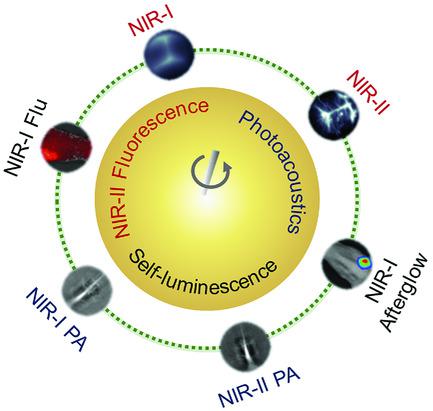当前位置:
X-MOL 学术
›
Adv. Mater.
›
论文详情
Our official English website, www.x-mol.net, welcomes your
feedback! (Note: you will need to create a separate account there.)
Organic Semiconducting Agents for Deep‐Tissue Molecular Imaging: Second Near‐Infrared Fluorescence, Self‐Luminescence, and Photoacoustics
Advanced Materials ( IF 27.4 ) Pub Date : 2018-07-29 , DOI: 10.1002/adma.201801778 Qingqing Miao 1 , Kanyi Pu 1
Advanced Materials ( IF 27.4 ) Pub Date : 2018-07-29 , DOI: 10.1002/adma.201801778 Qingqing Miao 1 , Kanyi Pu 1
Affiliation

|
Optical imaging has played a pivotal role in biology and medicine, but it faces challenges of relatively low tissue penetration and poor signal‐to‐background ratio due to light scattering and tissue autofluorescence. To overcome these issues, second near‐infrared fluorescence, self‐luminescence, and photoacoustic imaging have recently emerged, which utilize an optical region with reduced light–tissue interactions, eliminate real‐time light excitation, and detect acoustic signals with negligible attenuation, respectively. Because there are only a few endogenous molecules absorbing or emitting above the visible region, development of contrast agents is essential for those deep‐tissue optical imaging modalities. Organic semiconducting agents with π‐conjugated frameworks can be synthesized to meet different optical imaging requirements due to their easy chemical modification and legible structure–property relation. Herein, the deep‐tissue optical imaging applications of organic semiconducting agents including small‐molecule agents and nanoparticle derivatives are summarized. In particular, the molecular engineering and nanoformulation approaches to further improve the tissue penetration and detection sensitivity of these optical imaging modalities are highlighted. Finally, current challenges and potential opportunities in this emerging subfield of biomedical imaging are discussed.
中文翻译:

用于深层组织分子成像的有机半导体试剂:二次近红外荧光,自发光和光声
光学成像在生物学和医学中起着举足轻重的作用,但是由于光散射和组织自发荧光,它面临组织渗透率相对较低以及信噪比较差的挑战。为了克服这些问题,近来出现了第二种近红外荧光,自发光和光声成像技术,它们利用光组织相互作用减少的光学区域,消除了实时光激发,并以可忽略的衰减检测声信号。 。由于只有少数内源性分子在可见光区域上方吸收或发射,因此造影剂的开发对于这些深层组织光学成像模式至关重要。具有π共轭骨架的有机半导体可以合成,以满足不同的光学成像要求,这是因为它们具有易于化学修饰和清晰的结构-性质关系。本文总结了有机半导体在小分子药物和纳米粒子衍生物等方面的深层光学成像应用。特别地,突出了进一步改善组织渗透和这些光学成像方式的检测灵敏度的分子工程和纳米制剂方法。最后,讨论了这个新兴的生物医学成像子领域中的当前挑战和潜在机会。总结了有机半导体在小组织和纳米粒子衍生物等方面的深层光学成像应用。特别地,突出了进一步改善组织渗透和这些光学成像方式的检测灵敏度的分子工程和纳米制剂方法。最后,讨论了在新兴的生物医学成像子领域中的当前挑战和潜在机会。总结了有机半导体在小组织和纳米粒子衍生物等方面的深层光学成像应用。特别地,突出了进一步改善组织渗透和这些光学成像方式的检测灵敏度的分子工程和纳米制剂方法。最后,讨论了在新兴的生物医学成像子领域中的当前挑战和潜在机会。
更新日期:2018-07-29
中文翻译:

用于深层组织分子成像的有机半导体试剂:二次近红外荧光,自发光和光声
光学成像在生物学和医学中起着举足轻重的作用,但是由于光散射和组织自发荧光,它面临组织渗透率相对较低以及信噪比较差的挑战。为了克服这些问题,近来出现了第二种近红外荧光,自发光和光声成像技术,它们利用光组织相互作用减少的光学区域,消除了实时光激发,并以可忽略的衰减检测声信号。 。由于只有少数内源性分子在可见光区域上方吸收或发射,因此造影剂的开发对于这些深层组织光学成像模式至关重要。具有π共轭骨架的有机半导体可以合成,以满足不同的光学成像要求,这是因为它们具有易于化学修饰和清晰的结构-性质关系。本文总结了有机半导体在小分子药物和纳米粒子衍生物等方面的深层光学成像应用。特别地,突出了进一步改善组织渗透和这些光学成像方式的检测灵敏度的分子工程和纳米制剂方法。最后,讨论了这个新兴的生物医学成像子领域中的当前挑战和潜在机会。总结了有机半导体在小组织和纳米粒子衍生物等方面的深层光学成像应用。特别地,突出了进一步改善组织渗透和这些光学成像方式的检测灵敏度的分子工程和纳米制剂方法。最后,讨论了在新兴的生物医学成像子领域中的当前挑战和潜在机会。总结了有机半导体在小组织和纳米粒子衍生物等方面的深层光学成像应用。特别地,突出了进一步改善组织渗透和这些光学成像方式的检测灵敏度的分子工程和纳米制剂方法。最后,讨论了在新兴的生物医学成像子领域中的当前挑战和潜在机会。











































 京公网安备 11010802027423号
京公网安备 11010802027423号